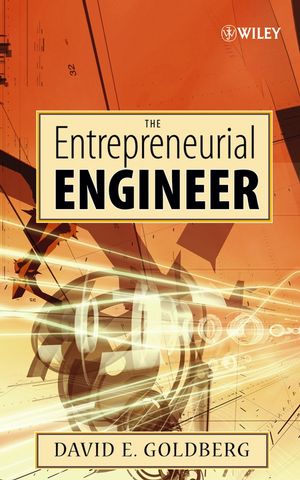The Entrepreneurial Engineer: Personal, Interpersonal, and Organizational Skills for Engineers in a World of OpportunityISBN: 978-0-470-00723-5
Hardcover
224 pages
September 2006
 This is a Print-on-Demand title. It will be printed specifically to fill your order. Please allow an additional 15-20 days delivery time. The book is not returnable.
|
||||||
1.1 21ST Century Engineers Moving at Internet Time.
1.2 Engineering Education, Common Sense & the Real World.
1.3 Ten Competencies for the Entrepreneurial Engineer.
1.4 Three Principles.
1.5 Three Cautions.
Exercises.
2. The Joy of Engineering.
2.1 A Joyous Confession.
2.2 Engineering as Liberal Education, Launch Pad & Lifelong Love.
2.2.1 Who is Getting a “Liberal Arts” Education Today?.
2.2.2 Engineering as Launch Pad.
2.2.3 10 ways to Love Engineering.
2.3 The Fundamental Tug-of-War.
2.4 Science and its Little Secret.
2.5 Engineers: First Masters of Modern Enterprise.
2.6 Economy of Intellection: Separating Science from Engineering.
2.6.1 The Modeling Plane.
2.6.2 Spectrum of Models.
2.7 Four Tensions Facing the Entrepreneurial Engineer.
Summary.
Exercises.
3. Money, Work, and You.
3.1 Money, Moola, the Big Bucks.
3.2 The Roads to Wealth: 4 Dinner Table Platitudes.
3.3 Hidden Lesson #1: Engagement.
3.3.1 Why Engagement Matters.
3.3.2 Matching Your Vocational Impedance.
3.4 Hidden Lesson #2: Courage.
3.4.1 Locus of Control: Internal versus External .
3.4.2 Exploring Courage.
3.5 Tactical Lessons of Handling Money.
3.5.1 Spending and Earning Styles.
3.5.2 Spending-Earning Impedance.
3.5.3 Investing, Saving, and Thrift.
3.6 Get a Life .
3.7 Plotting Your Course: Values, Mission, and Goals.
3.7.1 Creating a Personal Values Statement .
3.7.2 Writing a Personal Mission Statement.
3.7.3 Setting Goals .
Summary.
Exercises.
4. Getting Organized and Finding Time.
4.1 Time and Its Lack.
4.2 Effective Ways to Waste Time.
4.3 Seven Keys to Time Management .
4.3.1 A Place for Everything.
4.3.2 Work for Mr. To Do.
4.3.3 Sam Knows: Just Do It.
4.3.4 A Trash Can Is a Person’s Best Friend.
4.3.5 Tuning Your Reading.
4.3.6 Managing Interruptions.
4.3.7 Getting Help.
Summary.
Exercises.
5. Write for Your Life.
5.1 Engineers, Root Canal, and Writing.
5.2 Why Many Engineers Don’t Like to Write.
5.3 The Prime Directive of Writing: Just Write.
5.3.1 Freewriting.
5.3.2 Directed Writing for the Real World.
5.4 Getting the Content and Organization Right.
5.4.1 The Primary Structure of Business Writing: B-P-R.
5.4.2 Lists and Amplification: A Technical Writer’s Best Friend.
5.4.3 Sectioning, Titles, and Headings .
5.4.4 Summaries, Conclusions, and Distinguishing the Difference.
5.5 Edifying Editing .
5.6 Improving Your Writing.
Summary.
Exercises.
6. Present, Don’t Speak.
6.1 Speeches versus Presentations.
6.2 Why Present?.
6.3 Preparation Makes the Presentation.
6.3.1 Audience Analysis.
6.3.2 Subject Selection.
6.3.3 Elements of a Presentation.
6.3.4 Preparation Process.
6.3.5 Transparency Design and Preparation.
6.4 Delivery .
Summary.
Exercises.
7. The Human Side of Engineering.
7.1 The Human Challenges of Engineering.
7.2 Through the Eyes of Others.
7.3 Anatomy of a Disagreement.
7.4 We Are All Salesmen on this Bus.
7.5 The Role of Questions .
7.5.1 Questions in Conversation.
7.5.2 Questions in Conflict Resolution and Negotiation.
7.5.3 Questions in Sales and Persuasion.
7.6 Praise .
7.7 Criticism.
7.8 Engineering is Sometimes Having to Say You’re Sorry.
7.9 Wear a Little Passion.
Summary.
Exercises .
8. Ethics in Matters Small, Large, and Engineering.
8.1 Is Engineering Ethics Necessarily a Dreadful Bore?.
8.2 Ethics: The Systematic Study of Right and Wrong.
8.2.1 Golden Rules: Positive and Negative .
8.2.2 Whence Right and Wrong?.
8.2.3 An Engineer’s Synthesis of Ethical Theory.
8.3 From Ethical Theory to Practice.
8.3.1 Self-Interest.
8.3.2 Obedience to Authority.
8.3.3 Conformity to the Group.
8.3.4 Practice Makes Perfect.
8.4 From Personal to Engineering Ethics.
8.4.1 What is a Profession?.
8.4.2 A Tale of Two Codes .
8.4.3 Conflicts of Interest.
8.4.4 Whistleblowing is Not a First Resort.
Summary.
Exercises.
9. Pervasive Teamwork.
9.1 Our Love-Hate Relationship with Teams.
9.2 Working Together in Groups to Teams.
9.2.1 Groups and Teams: What’s the Difference?.
9.2.2 Team Basics.
9.2.3 Team Ground Rules ant Their Enforcement.
9.3 Understanding the Difficulties of Teamwork.
9.3.1 A Little Model of Teamwise Deciding and Doing.
9.3.2 A Little Model of Teamwise Conflict (and Creativity).
9.4 Why Cooperation Isn’t Easy.
9.5 Meetings, Meetings, and More Meetings.
9.5.1 Three Little Keys to Meeting Happiness.
9.5.2 A Day in the Life of a Typical Problem-Solving Meeting.
9.5.3 What’s Wrong?.
9.5.4 Structured Brainstorming .
9.5.5 Putting Structured Brainstorming to Work.
Summary.
Exercise.
10. Organizations and Leadership.
10.1 Organizations and Leadership Matter.
10.2 Understanding Human Behavior and Motivation.
10.2.1 Bounds on Human Nature.
10.2.2 A Unifying Model: Maslow’s Hierarchy of Needs.
10.2.3 Theory X and Theory Y.
10.2.4 Case of the Sluggish Secretary.
10.3 Human Organizations and their Leaders.
10.3.1 From Good to Great.
10.3.2 The Leadership Challenge.
10.4 Organizational Culture: The Gods of Management.
10.5 Why Form or Join Organizations?.
10.5.1 Optimizing Transactions: A Quantitative Model.
10.5.2 An Aside on Free Agency.
Summary.
Exercises.
11. Assessing Technology Opportunities.
11.1 Entrepreneurial Engineers Seek Opportunity.
11.2 What is an Opportunity?
11.3 Sustainable Competitive Advantage: The Making of a Good Opportunity.
11.3.1 The Four Ps of Competitive Advantage.
11.3.2 The Five Forces of Sustainability.
11.4 What is Your Niche?.
11.5 Three Financial Mysteries of Opportunity Assessment.
11.5.1 Overcoming the Fear of Financials.
11.5.2 Prices, Margins, and Breaking Even.
11.5.3 The Time Value of Money.
11.6 Writing the Technology Opportunity Assessment.
11.6.1 Executive Summary.
11.6.2 Technology Description.
11.6.3 Market Analysis.
11.6.4 Preliminary Financial Analysis.
11.6.5 Action Plan.
Summary.
Exercises.
References.



